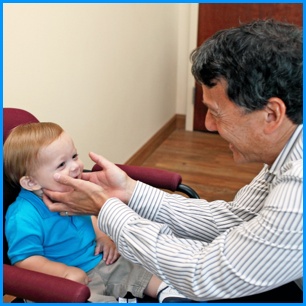- Salivary Gland Infections
- Juvenile Parotitis
- Mucocele
- Ranula
- Salivary Gland Stones
- Salivary Gland Mass
Salivary Gland Infections
Salivary glands infections are common in children and are caused by bacteria or viral infections of either the parotid, submandibular, or less commonly the sublingual glands.
- Parotid Glands – These are the two largest salivary glands and are located in each cheek, in front of the ears and over the child’s jaw
- Submandibular glands – The submandibular glands are located under both sides of a child’s jaw
- Sublingual glands – These are located inside the mouth under your child’s tongue

Infections of these glands can present with swelling, pain, warmth and redness at the gland. Occasionally your child can also get fevers or a bad taste in the mouth. The diagnosis of an infection is most commonly made with a careful history and examination. Occasionally your pediatric ENT physician may want to get an ultrasound or CT scan if there is a concern for another problem.
Bacterial infections are best treated with antibiotics, warm compresses, massaging the gland and drinking plenty of fluids. Sucking on sour candies is also helpful to encourage lots of saliva flow to flush out the infection. Viral infections are treated in the same manner but without antibiotics. Mumps should be tested for if your child has not been immunized.
Tuberculosis bacteria may also cause an infection in a child’s salivary glands. This bacterium can enter either the parotid or submandibular gland. Symptoms may be similar to a typical salivary gland infection; however, these infections may not improve with typical antibiotics. If the infection worsens your ENT for Children specialist may diagnose your child’s condition through a histological analysis and culture before recommending treatment. Long term anti-tuberculosis antibiotics and occasionally surgery are required to get complete treatment of these infections.
Juvenile Parotitis
Juvenile parotitis is an inflammatory disease that may occur in a child’s parotid salivary gland. The inflammation may appear as a unilateral (on one side) or bilateral (on both sides) and can recur as the child grows older.
The cause of this disorder is not known but may be from recurring bacterial infections. Your ENT for Children specialist may recommend blood tests, special x-rays or consultation with a Pediatric Rheumatologist to see if your child has any autoimmune disorders. Treatment is usually non-surgical with antibiotics, warm compresses, massaging the gland and drinking plenty of fluids. If conservative treatment fails, your pediatric ENT surgeon will discuss different surgery options.
Mucocele
Mucoceles (mucus filled cysts) occur from blocked minor salivary glands. These minor salivary glands are very small and are located throughout the mouth and throat and on the lips; thus mucoceles can occur anywhere in these areas. These cysts may continue to get larger or rupture on their own. Although most mucoceles are harmless and may disappear on their own, your ENT for Children surgeon may recommend treatment if your child’s condition is recurrent or if the mucoceles appear in the form of hard or permanent nodules. If the cyst becomes infected, your child may be placed on antibiotics and need to have the cyst drained.
Ranula
A ranula is essentially a larger type of mucocele. This cyst is larger because it usually forms from the larger sublingual gland under the tongue, which produces more saliva. A ranula may appear in the following ways:
- Sublingual Ranula – A sublingual ranula appears as a bluish, soft swelling under a child’s tongue.
- Cervical Ranula – Also known as a plunging ranula, this type of ranula has extended deeper into the neck and presents with a soft swelling on the outside of the neck.
While smaller ranulas may heal on their own, children may experience discomfort if the cyst is large and makes it difficult for him/her to chew or swallow. The cyst fluid is also at risk for becoming infected. Your ENT for Children specialist may recommend surgery to remove the ranula and the sublingual gland if it is causing problems or enlarging. If the ranula is sublingual and smaller, it may be able to be removed through the mouth; if it is larger or plunging, then an incision through the neck may be required.
Salivary Gland Stones

Salivary gland stones, also known as salivary duct stones, are stones that may form inside a child’s salivary glands. These stones can become lodged in the small ducts of the gland, which the saliva flows through. The obstruction of the salivary ducts may make it difficult for the glands to secrete saliva causing pain, swelling and possibly infections. The swelling often occurs prior to, or during a meal when the saliva production is highest.
The stones are composed of minerals salts that are in the saliva. If there is a concern for a salivary stone it can be identified by different methods. Occasionally the stone can be felt in the mouth or seen stuck at the very end of the saliva duct. If it is not felt, then your pediatric ENT may recommend performing a CT scan to detect stones that are deeper. Treatment of salivary stones requires removal of the stone(s). Your ENT for Children surgeon will discuss the various methods for salivary stone removal. If stones keep forming or there are several stones within a gland, your surgeon may recommend removal of the entire gland to permanently treat the problem.
Salivary Gland Mass
Head and neck tumors in children are rare; however the salivary glands are one area where they can occur. Most of these masses arise in older children or teenagers. Almost all salivary gland tumors present as an enlarging, painless lump in the check, face or under the jaw. To determine whether the mass is benign or malignant (cancerous), your ENT for Children specialist will want to get a sample of the mass with a needle biopsy. We will also discuss getting an MRI or CT scan to better characterize the mass. Treatment of the mass will depend of the type of tumor it is.
- Benign Neoplasms – A benign salivary gland neoplasm will only have local growth at the site; it will not spread.
- Malignant Neoplasms – A malignant salivary gland neoplasm may spread into other areas. A child who suffers from the condition might also experience pain and discomfort at the site. Also, there may be weakness of the face if the tumor has affected the facial nerve branches.
Once the type of tumor is known and whether it has spread, the appropriate treatment will be discussed, which may include surgery to remove the tumor.
